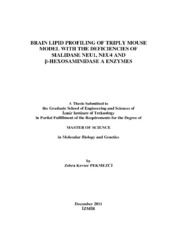Please use this identifier to cite or link to this item:
https://hdl.handle.net/11147/3185Full metadata record
| DC Field | Value | Language |
|---|---|---|
| dc.contributor.advisor | Seyrantepe, Volkan | en |
| dc.contributor.author | Pekmezci, Zehra Kevser | - |
| dc.date.accessioned | 2014-07-22T13:51:02Z | - |
| dc.date.available | 2014-07-22T13:51:02Z | - |
| dc.date.issued | 2011 | en |
| dc.identifier.uri | http://hdl.handle.net/11147/3185 | - |
| dc.description | Thesis (Master)--Izmir Institute of Technology, Molecular Biology and Genetics, Izmir, 2011 | en |
| dc.description | Includes bibliographical references (leaves: 41-61) | en |
| dc.description | Text in English; Abstract: Turkish and English | en |
| dc.description | xi, 61 leaves | en |
| dc.description.abstract | Tay-Sachs disease is a severe lysosomal storage disorder caused by mutations in the HEXA gene coding for α subunit of lysosomal β-hexosaminidase A enzyme, which converts GM2 to GM3 ganglioside. HexA-/- mice, depleted of β-hexosaminidase A enzyme, remain asymptomatic to 1 year of age, so it was thought there is a difference between human and mice lipid degradation. Previously identified a novel ganglioside metabolizing sialidase, Neu4, is abundantly expressed in mouse brain neurons. It was demonstrated that mice with targeted disruption of both HexA and Neu4 genes (HexA-/- Neu4-/-) show accumulating GM2 ganglioside and epileptic seizures with 40% penetrance. Since all mice didn't show symptoms, it was suggested that Neu4 is not the only sialidase contributing to the metabolic bypass in HexA-/- mice (Seyrantepe et al. 2010). Therefore, we studied the role of another sialidase Neu 1 in glycolipid degradation. We profiled brain glycolipid content of triple deficient mouse model with the deficiency of β-hexosaminidase A (0% activity), sialidase Neu4 (0% activity) and sialidase Neu 1 (10% activity) (NeoIn) by thin layer chromatography. Analysis of both double (HexA-/-NeoIn-/-) and triple (HexA-/-Neu4-/-NeoIn-/-) mice models showed that sialidase Neu 1 deficency causes not significant difference in brain lipid profile and though also other sialidase/sialidases might have role in glycolipid degradation pathway in mice. | en |
| dc.language.iso | en | en_US |
| dc.publisher | Izmir Institute of Technology | en |
| dc.rights | info:eu-repo/semantics/openAccess | en_US |
| dc.subject.lcsh | Tay-Sachs disease | en |
| dc.subject.lcsh | Gangliosides | en |
| dc.subject.lcsh | Neurasthenia | en |
| dc.subject.lcsh | Mice as laboratory animals | en |
| dc.subject.lcsh | Thin layer chromatography | en |
| dc.title | Brain lipid profiling of triply mouse model with the deficiencies of sialidase neu1, neu4 and ß-hexosaminidase a enzymes | en_US |
| dc.type | Master Thesis | en_US |
| dc.institutionauthor | Pekmezci, Zehra Kevser | - |
| dc.department | Thesis (Master)--İzmir Institute of Technology, Molecular Biology and Genetics | en_US |
| dc.relation.publicationcategory | Tez | en_US |
| item.grantfulltext | open | - |
| item.openairetype | Master Thesis | - |
| item.fulltext | With Fulltext | - |
| item.cerifentitytype | Publications | - |
| item.openairecristype | http://purl.org/coar/resource_type/c_18cf | - |
| item.languageiso639-1 | en | - |
| Appears in Collections: | Master Degree / Yüksek Lisans Tezleri | |
Files in This Item:
| File | Description | Size | Format | |
|---|---|---|---|---|
| T001004.pdf | MasterThesis | 1.84 MB | Adobe PDF |  View/Open |
CORE Recommender
Page view(s)
112
checked on Jul 15, 2024
Download(s)
40
checked on Jul 15, 2024
Google ScholarTM
Check
Items in GCRIS Repository are protected by copyright, with all rights reserved, unless otherwise indicated.